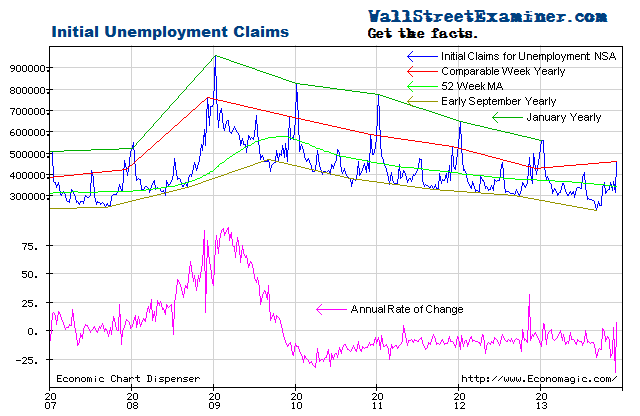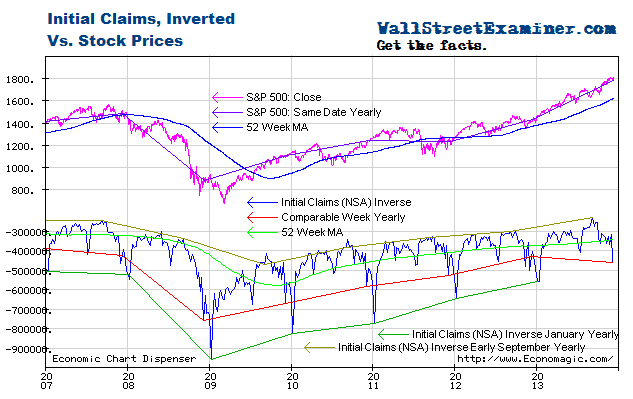Courtesy of Lee Adler of the Wall Street Examiner
This report is an excerpt from the permanent Employment Charts page, updated when new data becomes available. Also updated today JOLTS and Average Weekly and Hourly Earnings and Hours Worked.
The Labor Department reported that the seasonally adjusted (SA) representation of first time claims for unemployment rose by 4,000 to 371,000 from a revised 367,000 (was 372,000) in the advance report for the week ended January 5, 2013. The number was worse than the consensus median estimate of 364,000 reported by Briefing.com in a survey of economists. Bloomberg reported a median estimate of 365,000. Dow Jones, which uses Econoday, had the consensus at 362,000. The reported number was closer than usual to the estimates this week, but the seasonal adjustment process remains a haphazard and arbitrary process that always yields a fictitious number.
The headline seasonally adjusted data is the only data the media reports but the Department of Labor (DOL) also reports the not seasonally adjusted data (NSA). The DOL said in today’s press release, “The advance number of actual initial claims under state programs, unadjusted, totaled 552,043 in the week ending Jnaury 5, an increase of 61,944 from the previous week. There were 646,219 initial claims in the comparable week in 2011.” [Added emphasis mine] The year to year decline was at the rate of -14.3%. In the prior week the year to year rate of decline was -7.3%.
Note: The DOL specifically warns that this is an advance number and states that not seasonally adjusted numbers are the actual number of claimants from summed state claims data. The advance number is virtually always adjusted upward the following week because interstate claims from many states are not included in the advance number. The final number is usually 2,000 to 4,000 higher than the advance estimate. I adjust for this in analyzing the data.
Normally the increase between the advance number and the final number the following week has been around 2,000-4,000. The current week was an extremely rare downward revision, likely due to a reporting error from one of the states. I adjusted this week’s reported number up by 2,000, which is at the low end of the typical range of revisions. The adjusted number that I used in the data calculations is 554,000, rounded. On this basis, the year to year decrease in initial claims was approximately -92,000 or -14.3% versus a drop of 7.3% last week.
Note: To avoid the confusion inherent in the fictitious SA data, I analyze the actual numbers of claims (NSA). It is a simple matter to extract the trend from the actual data and compare the latest week’s actual performance to the trend, to last year, and to the average performance for the week over the prior 10 years. It’s easy to see graphically whether the trend is accelerating, decelerating, or about the same.
The week to week change of an increase of 64,000 was slightly greater than the average increase for the first weekly report in January. Over the previous 10 years the comparable week has virtually always had big increases. The average change for the 10 years from 2003 to 2012 was an increase of approximately 49,000. However, this year was much better than 2012 when claims increased by 106,000 in that week. The first week of 2011 had an increase of 53,000. This year was stronger than 4 of the past 10 years. The number wasn’t great, but it wasn’t bad, and it was well within the recent trend of improvement. There has been little giveback from strong readings over the past several weeks.
From mid 2010 through mid October 2012 the annual rate of change in initial claims had ranged from -3% to -20% every week, with a couple of temporary minor exceptions, including the Superstorm Sandy surge. Since mid 2011 the annual rate of change was within a couple of percent of -10% in most weeks. The trend was remarkably consistent.
A second trend has become visible on the annual rate of change graph (bottom of chart below). It shows a channel of slightly higher lows and higher highs indicating a slowing rate of improvement as the trend moved toward zero year to year change. The December 8th week’s annual rate of change at -1.2% was at the upper limit of that channel. The current weekly reading of -14.3% is in the lower half of the channel and also the lower half of the overall range of the past 2 years, indicative of a very strong reading. The improving trend continues. It will be interesting to see if the Fed’s more aggressive money printing in 2013 will impact that trend. History suggests that it will, but that there will be costly unintended consequences attached.
Plotted on an inverse scale, the correlation of the trend of claims with the trend of stock prices over the longer term is strong, while allowing for wide intermediate term swings in stock prices. Both trends are largely driven by the Fed’s operations with Primary Dealers (covered weekly in the Professional Edition Fed Report; See also The Conomy Game, a free report). The chart below now suggests that the market trend will be overbought at approximately 1500, assuming that the trend in claims remains relatively constant. But will the additional Fed money printing that is now under way cause those trends to tilt more steeply upward? I suspect that the answer is yes, in the short to intermediate term.
When the market became extended relative to the unemployment claims trend in 2011, the Fed was simultaneously ending QE2, thus starving the monster of its lifeblood. As a result the market pulled back sharply after reaching the top of the channel This year, the Fed is intent on fattening the bull. The expansion of QE means that the Fed’s balance sheet will now grow by a 38% annual rate sending lots of cash toward and through the market with some of it trickling into the economy for the duration of the program. That would allow the S&P to bump along the top of the channel as long as the jobs trend stays intact.
Some bubble jobs will likely be created in the process. However, the inflation that should accompany the money printing, whether in asset prices, commodities, or in consumer prices, should eventually force the Fed to stop QE. At that point the markets and economy will have to deal with the hangover from the program.
Get regular updates the machinations of the Fed, Treasury, Primary Dealers and foreign central banks in the US market, in the Fed Report in the Professional Edition, Money Liquidity, and Real Estate Package. Click this link to try WSE's Professional Edition risk free for 30 days!
Copyright © 2012 The Wall Street Examiner. All Rights Reserved. The above may be reposted with attribution and a prominent link to the Wall Street Examiner.





